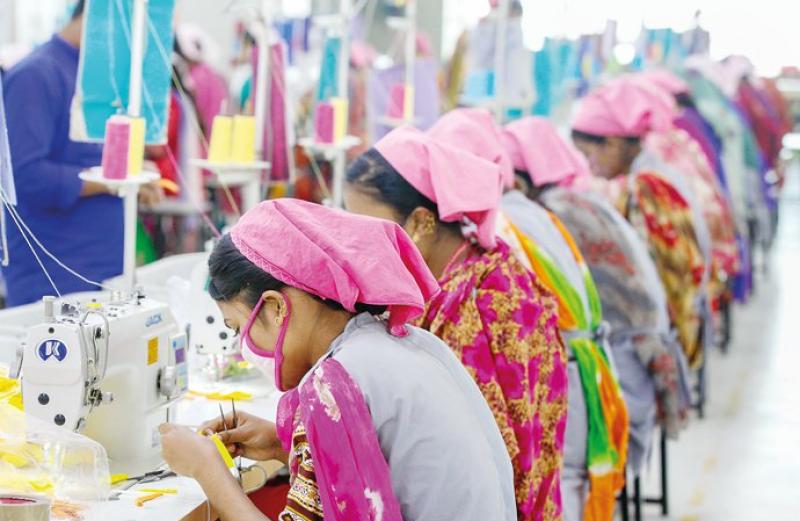 In what could be seen as an ominous sign for Bangladesh’s apparel exports, a new report predicts that by the middle of the next decade, more and more Americans and Europeans will wear clothes made closer to home.
In what could be seen as an ominous sign for Bangladesh’s apparel exports, a new report predicts that by the middle of the next decade, more and more Americans and Europeans will wear clothes made closer to home.
Speedy shifts in fashion trends needing quick turnaround, rising automation and the impact of tariffs will make “nearshoring” far more attractive for apparel chains, says the report released by consulting firm McKinsey and Company.
Based on a survey of 188 apparel industry representatives, the report notes that 79 percent executives admit “nearshoring for speed is somewhat or highly likely by 2025.”
Titled “Is apparel manufacturing coming home?”, the McKinsey report says a US apparel company that moves production of basic jeans from either Bangladesh or China to Mexico can maintain or even slightly increase its margin.
For Europe, unit costs still remain significantly lower when sourcing from Bangladesh, but reshoring from China to Turkey is economically viable.
It says a pair of jeans in 2016 and 2017, including 30-day ocean freight shipping, cost $12.04 a pair when made in China, and only 17 percent more, or $14.05, to be made right in the US. That cost premium would be worthwhile, the study said, considering the shipping time saved and thus the possibility of selling products more likely to be on-trend.
It cost $10.68 in Bangladesh, but considering two-day truck shipping, making that pair of jeans in Mexico actually cost just $10.57, says the report. The report says that by reducing “time-to-market”, the apparel companies can react to latest trends within a single season.
The report says that by reducing “time-to-market”, the apparel companies can react to latest trends within a single season.
“It used to be that a six-month fashion cycle was considered fast. Today, speedy time-to-market means no more than six weeks, and some retailers are able to do it even faster,” says the McKinsey report.
Along with the incompatibility of the offshoring model with the new need for speed, the report also cites the new advances in automation as the reason for "nearshoring".
It says sewing a pair of jeans now takes an average of 19 minutes, more than half of the total production time, but robotics can cut that time by 40-90 percent. Digital printing could reduce labor for finishing garments by as much as 70 percent.
More than eighty percent of the executives surveyed by McKinsey say the production of simple garments will be fully automated by 2025.
The study comes out at a time when export figures for Bangladesh ready-made garments show a rise of more than 14.5 percent year-on-year for the September quarter.
The US and the EU are the biggest importers of garments made in Bangladesh. It continues to be among the top three garment-exporters in the world and as a survey from the same group, McKinsey and Co, had noted “Bangladesh was the most preferred apparel sourcing destination after China.”
The apparel industry has also displayed tremendous resilience after the Rana Plaza incident and the outcry that followed, but experts believe that it cannot rely on the same model of success.
It will have to adapt to the new emerging trends in automation and innovation-- what many are calling as the fourth industrial revolution--to stay competitive.
 Business
Business
30922 hour(s) 43 minute(s) ago ;
Morning 05:37 ; Saturday ; Apr 27, 2024
Speedy fashion a risk to Bangladesh apparel exports: Report
Send
Brajesh Upadhyay, Washington
Published : 08:37, Oct 24, 2018 | Updated : 08:37, Oct 24, 2018
Published : 08:37, Oct 24, 2018 | Updated : 08:37, Oct 24, 2018
0 ...0 ...
/pdn/
Topics: Top Stories
- KOICA donates medical supplies to BSMMU
- 5 more flights to take back British nationals to London
- Covid19: Rajarbagh, Mohammadpur worst affected
- Momen joins UN solidarity song over COVID-19 combat
- Covid-19: OIC to hold special meeting
- WFP begins food distribution in Cox’s Bazar
- WFP begins food distribution in Cox’s Bazar
- 290 return home to Australia
- Third charter flight for US citizens to return home
- Dhaka proposes to postpone D8 Summit
Unauthorized use of news, image, information, etc published by Bangla Tribune is punishable by copyright law. Appropriate legal steps will be taken by the management against any person or body that infringes those laws.
Bangla Tribune is one of the most revered online newspapers in Bangladesh, due to its reputation of neutral coverage and incisive analysis.
F R Tower, 8/C Panthapath, Shukrabad, Dhaka-1207 | Phone: 58151324; 58151326, Fax: 58151329 | Mob: 01730794527, 01730794528






